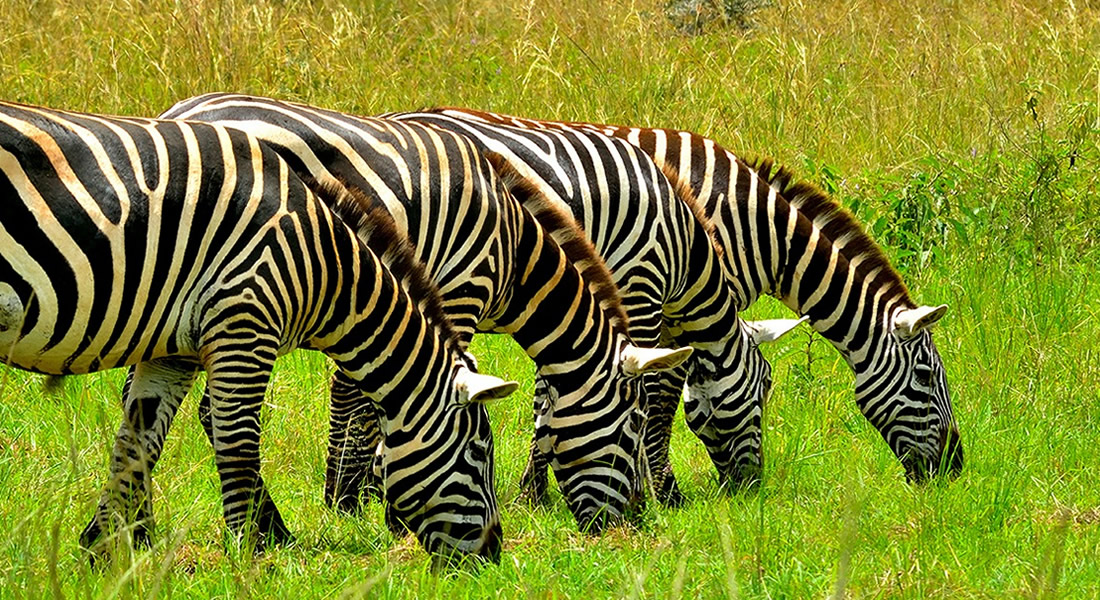In the Western Region of Uganda, in the Kiruhura region, Lake Mburo National Park is about 240 kilometers from Kampala, the country’s capital. The park is the smallest of Uganda’s savanna National Parks, measuring 370km2, and is renowned as the closest National Park to Kampala. Getting there requires a 3–4-hour journey. A startling variety of plants and animals call its mosaic ecosystem, arid hillside, rocky outcrops, bushes thickets, open and wooded savanna woodlands, lakes, and swamps home. The newest wildlife preserve, Lake Mburo National Park, contains a sizable area of wetland that provides you with a rare opportunity to see different species of mammals and birds in this region. It also has a diverse mosaic of habitats and landscapes, including forests known as Rubanga forests, grasslands, and open savannah. There are several hippos wading in the water, giant crocodiles hiding on the shoreline, and a large herd of zebra, buffalo, impalas, elands, and antelopes at Lake Mburo National Park, which is an extension of the Tanzanian plain. Cormorant, fish eagle, pelican, heron, and many other birds are examples of birds.

About 68 different species of mammals live in Lake Mburo National Park, including zebras, impalas, buffaloes, topis, elands, bushbucks, warthogs, leopards, hyenas, and jackals. The best time to observe a leopard in Uganda is during a night game drive, and Lake Mburo is also the best location for walking safaris because it is free of elephants and lions. A diverse mosaic of habitats, including forest galleries, seasonal and permanent swamps, and lush acacia wood valleys, make up its sculptured environment, which includes rolling grassy hills and an idyllic lakefront. These habitats all sustain a variety of wildlife.
A rare shoebill stork, papyrus yellow warbler, African finfoot, saddle billed stork, brown chested wattled plover, Carruthers Cisticola, Tabora Cisticola, great snipe, Abyssinian ground hornbill, African fish eagle, saddle billed stork, and white-winged warbler are just a few of the more than 315 bird species found in the park. The Acacia, Olea, and Boscia species dominate the woody vegetation of Lake Mburo. The greatest spot in Uganda to see acacia-dwelling birds is Lake Mburo. The park’s bordering marshes also contain secretive papyrus specialists like the red, black, and yellow papyrus gonalek. The black-collared barbet and the southern ground hornbill are two examples of southern species that can be found at Lake Mburo National Park near the northernmost extent of their distribution.
Tourist Activities in Lake Mburo National Park
Boat Cruise
A boat excursion allows you to get a closer look at the lake’s powerful crocodiles, antelopes, buffaloes, and three different varieties of otters. Even the most knowledgeable birder frequently finds it difficult to identify every species of waterbird, including the rare shoebill, African Fish eagles, blue-headed weavers, Rufus long-tailed starlings, pied kingfishers, hammer, and kobs. These wonderful wildlife encounters, along with the breathtaking vistas and panoramic views of the environment, will certainly make you appreciate the true magnificence of Africa.
Bird Watching
The rare Coqui Francolin, Emerald-spotted Wood, Rufous-bellied Heron, Bateleur, Brown-chested Lapwing, Grey Crowned Crane, Bare-faced Go-Away-Bird, Red-faced Barbet, Green Wood-hoopoe, Red-headed Lovebird, Ross’s Turaco, Black-bellied Bustard, and Nubian Woodpecker are just a few of the rare bird species found in the park. On the boat excursion, you can see birds such as malachite kingfishers, African Fish eagles, blue-headed weavers, Rufus long-tailed starlings, pied kingfishers, hammer, kobs, Herons, pelicans, and the unique shoebill.
Fishing in Lake Mburo
Lake Mburo has around 6 species of fish with Tilapia being the most common one. The most fishing spot is at Mazinga the travelers that are planning to carry out fishing here should bring their own fishing gears and then get a permit from Uganda Wildlife Authority.
Horse riding
Horse riding Safari in Lake Mburo Park is a safe and sane experience with knowledgeable guides as you explore the rolling savanna of Lake Mburo National Park –horseback riding gives you the best way of viewing the wildlife that found in the park including Giraffes, Giant Elands, also Topi, Impala, Duikers, Bushbucks, Waterbucks, Burchell Zebras, these can also last between 1 to 3 hours as you enjoy the scenic beauty, Birds, Vegetation of the Park. You can also enjoy overnight horseback riding that can be offered with tents as well as meals in the wild.
Nature walk
Lake Mburo is open to the walkers as well as they are followed by the ranger guide. At Rwonyo, the guided walk will lead you to the salt lick where you will find many animals that are attracted to the salty rocks.
Forest walks Rubanga
The forest also gives many habitats that are great for the birders making it so special for the bird watchers. There are also 40 bird species in Rubanga, making 5 of them being specialists as well as exploring a close canopy for Rubanga forest.
Guided bike rides
This is the best way of getting closer to nature as another way of adventuring Lake Mburo with its surrounding area. Riding a bike in Lake Mburo brings you closer with wildlife animals such as zebras, antelopes, buffaloes which can last from 1 hour. There are so many challenging options or the avid mountain biker due to the terrain of the lake is also diverse in nature.
Accommodation in Lake Mburo National Park
Mihingo Safari Lodge, Mantana Tented Camp, Arcadia Cottages, Mburo Safari Lodge, Rwakobo Rock, and Eagle’s Nest, as well as a conservation education center, are just a few of the park’s lodging options.
